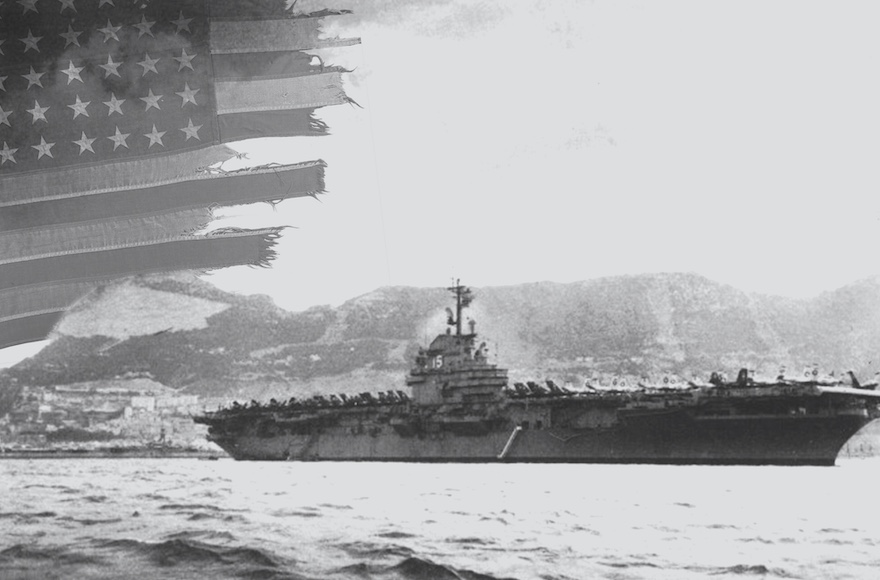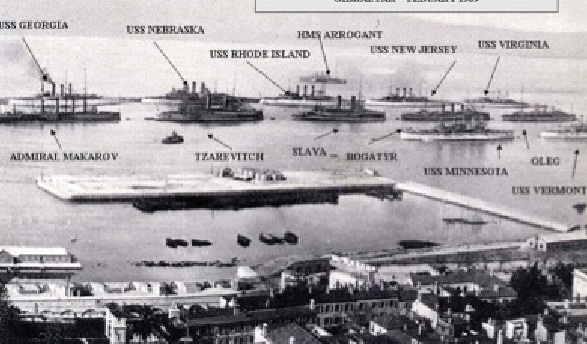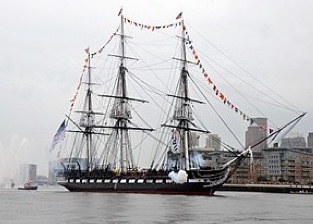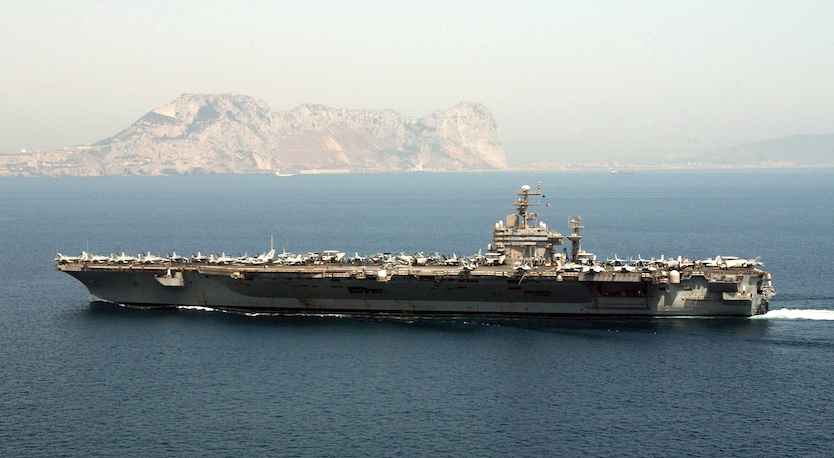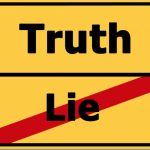Eagles on The Rock
The genesis of United States Navy activity at Gibraltar.
One of post-modern history’s closest and strategically relevant alliances is the Special Relationship that has existed between the United Kingdom and the United States of America primarily since the Second World War. It is thus unsurprising that the zenith of United States naval activity in Gibraltar covers a period from the beginning of the First World War until 2009 when the last United States Navy surface warship visited us in the form of USS De Wert on the 27th of September 2009.
During these golden years, we have seen vessels from battleships such as USS Iowa, open to visitors with much success in July 1989, to nuclear powered aircraft carriers (USS Nimitz in October 1976) visit the naval base. Vessels with names such as USS Bainbridge, Farragut, Decatur, Oliver Hazard Perry and Preble were very common visitors. It was whilst asking the question “who were the men who gave their names to these ships?” that I uncovered a locally seldom noticed but hugely relevant segment of our (and by extension United States) naval history.
Right from the outset, it can be argued that it was events occurring very close to our shores that served as one of the main deciding factors for the newly nascent United States to establish a professional navy. As early as 1784 the activity of Barbary pirates in the Strait of Gibraltar was threatening American merchant trade. That year the brig Betsy was captured off Morocco and a long tradition by Barbary states of capturing western merchant vessels and enslaving their crew with a view to extorting a ransom from the flag carriers was extended to the United States. This served in part to ignite a debate which culminated in a bill dated 27th March 1794 to construct 6 frigates, this marked the birth not only of the United States Navy as we know it today but of the construction of their most famous warship, the 44-gun sailing frigate USS Constitution ‘Old Ironsides’ which was destined to have a long association with Gibraltar during her service at sea, visiting us on several occasions over several decades and can still be visited today at Boston, Massachusetts.
It did not therefore take long for the United States Navy to begin to appear at Gibraltar, the piracy issue has worsened by 1800 and on the 15th May 1801 a squadron was despatched to the Mediterranean to attempt to deal with the threat. A small plaque situated adjacent to the American War Memorial commemorates the arrival of this fleet on the 1st July 1801 marking the first visit of the United States Navy to Gibraltar.
Some notable names formed part of this unit which was commanded by Commodore Richard Dale and was made up of the frigates USS President, Capt, J. Barron, USS Philadelphia, Capt. S. Barron, USS Essex, Capt. W. Bainbridge with the soon to be famous Stephen Decatur as 1st Lieutenant and the brig USS Enterprise, Lt. A. Stewart.
Interestingly, despite having been at war with the United Kingdom a few decades before, the fleet was welcomed in Gibraltar.
This fleet left for home waters in the Spring of 1802 but was replaced by a squadron led by Commodore Edward Preble which included the frigates
This squadron arrived in Gibraltar on 12th September 1803, the same day that the future naval hero of the War of 1812 Commodore John Rodgers arrived whilst transiting home aboard USS New York.
Unfortunately USS Philadelphia ran aground and was captured off Tripoli on the 31st October of that year. She was burned by US Naval forces on the 16th February 1804 in a very daring raid by a small fleet led by Lieutenant Stephen Decatur. This raid made Decatur a national hero overnight with Nelson himself describing the action as ‘the most bold and daring act of the age’.
Naturally, the War of 1812 between the United States and Great Britain caused an end to their activity in Gibraltar until 1815 but soon after the end of hostilities, visits began as normal. Sadly for Decatur though, with fame came envy from among his peers. This was to boil over in a scandal which very nearly brought an early end to the United States Navy, the incident in question occurred off Europa Point on the 7th October 1815. On that day the prickly (now Commodore) William Bainbridge had hauled up his anchor aboard the 90-gun ship of the line USS Independence and was preparing to leave the harbour and transit home, at the same time Stephen Decatur was sighted rounding Europa Point aboard the frigate USS Guerriere. Decatur duly made his signal to Bainbridge and saluted the senior officer. This salute was returned by USS Independence. All was well until Decatur lowered a ship’s boat and intended to pay a visit to Bainbridge. The latter, smarting at the success of the junior officer and his own inability to bring about any similar success himself, maintained course and speed, ignoring the boat. Finally Decatur managed to catch up and secure alongside the chains of USS Independence. He was met with a formal albeit icy reception in her captain’s cabin. History unfortunately does not record what was said but the incident caused significant shockwaves in United States naval and political circles.
The two decades of conflict with the Barbary States was often the proving ground for young officers who would later become famous commanders on both sides during the American Civil War which began in 1861. Examples include the hero of the battles of New Orleans and Mobile Bay, Admiral David Farragut who was commissioned as an Acting Lieutenant aboard USS Shark whilst at anchor in Gibraltar. Similarly the Confederates were no strangers to the Rock prior to the rebellion with the commanding officer of the ironclad CSS Virginia which fought USS Monitor at the battle of Hampton Roads, Franklin Buchanan visiting as a midshipman aboard USS Java in early 1816 under the command of the hero of the battle Lake Erie during the War of 1812, Oliver Hazard Perry.
Not all the incidents which unite our city’s history with the United States Navy involve heroes and battles, the story is marred with disaster when the sidewheel steam frigate USS Missouri caught fire and sank on the 26th August 1843 whilst at anchor in the harbour. Gladly as well as HMS Malabar assisting, the governor at the time, Sir Robert Thomas Wilson opened up the gates of the city and naval base to the survivors, a spontaneous act of kindness which was rewarded by a resolution of appreciation by the United States Congress.
Lastly our city became the focus of a tense engagement during the Civil War when in April 1862 the Confederate warship CSS Sumter was forced to call at Gibraltar in need of coal and repairs where she was monitored by a Union fleet. Tied up by commercial interests with the Confederacy but unwilling to incur the displeasure of the Union, Britain eventually reluctantly declined to offer Sumter any assistance as a warship and she was eventually sold and renamed SS Gibraltar. The vessel then continued blockade running for the Confederacy under British colours. Her captain was the famous Confederate officer Raphael Semmes. Sumter’s logbook details his time at Gibraltar exhaustively during which he mentions the city and attending bullfights at San Roque. (See also HSG June 2011)
Later into the 19th century George Dewey the hero of the Battle of Manila Bay during the Spanish-American war in which the United States Navy decisively defeated a Spanish fleet on the 1st May 1898 called at Gibraltar during his post-war round the world tour.
This was followed by the arrival of the Great White Fleet from 31st January to 6th February 1909 on their famous round the world cruise. This significant visit is seen as the first step towards the United States Navy emerging from a relatively small coastal fleet to the truly ocean going superpower that we know it to be today. It set the stage for its scale of operations during both world wars, the Cold War and beyond. (See also HSG Sept. 2011)
Whilst the sheer scale of United States Navy involvement in Gibraltar from the First World War onwards is far too large for this scope of this article, what can clearly be seen is that right from its earliest days the United States Navy has been a frequent visitor to our city. It has been the proving ground for a great many, if not virtually all of its early naval heroes. There is hardly a biography of any of them which doesn’t mention Gibraltar.
The lasting legacy of the effect of these visits on the local population can be illustrated by the visit of the oiler USNS Leroy Grumman earlier this year, among local shipping enthusiasts a visit by the ‘haze grey’ as US naval vessels are known is a highlight of the ship spotting calendar. It will always stir hearts when the Eagle comes to the Rock.

